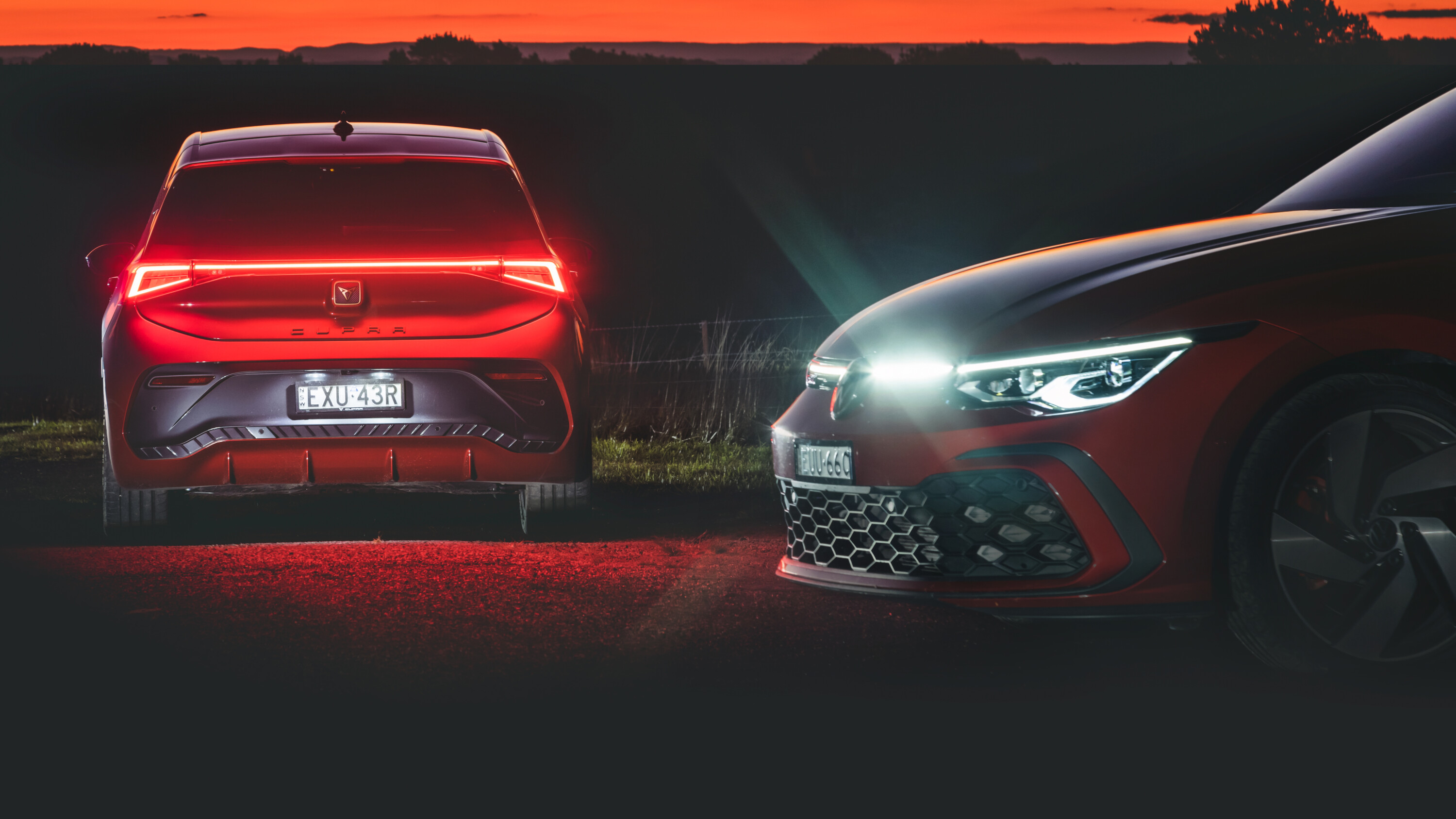

As the countdown begins for the baton pass from petrol power to all-electric propulsion, some unexpectedly intriguing options are beginning to present themselves for hot-hatch fans.
All of which begs the question: “Should my next spicy five-door be a rasping turbocharged petrol or should I explore what’s out there from the new ‘silent generation’ – the torque-rich battery electric vehicle?”
Performance purists will argue that buying a proper performance hatch while you still can is the only answer. The eighth-generation Volkswagen Golf GTI you see here will likely be the last all-petrol model in a lineage that stretches back almost 50 years – apart from an imminent (and final) mid-life facelift for the Mk8 – before the iconic Golf nameplate transitions towards electrification.
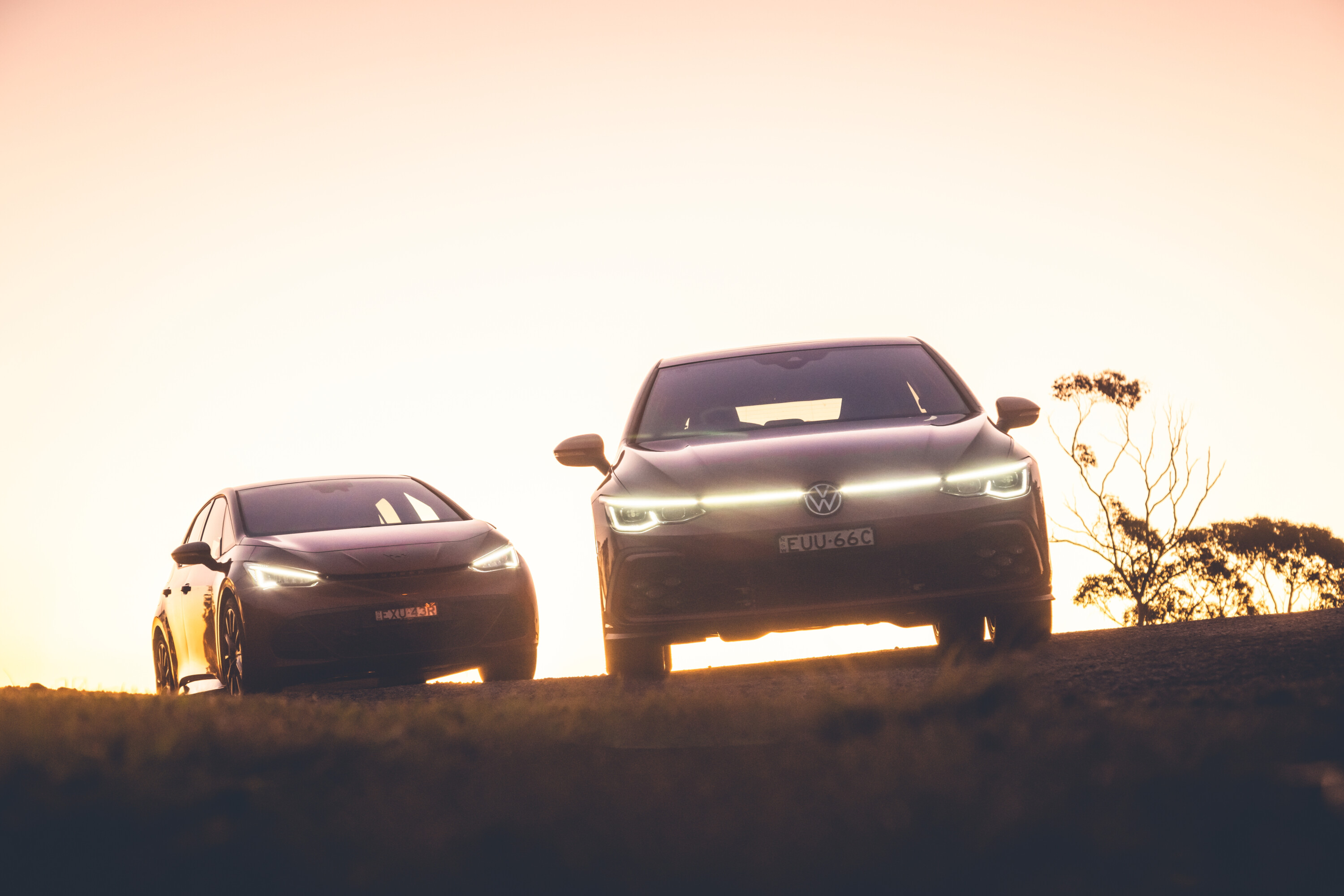
But from the greater Volkswagen Group’s own stable comes the Cupra Born – a Spanish-bred EV being touted as the first-ever electric hot hatch.
So what we’re here to investigate is whether this potentially inflated claim contains more hot air than a wind farm, or whether the Cupra Born truly is the blueprint for our hot-hatch future.
Given that today’s Golf GTI leans more towards the hardcore end of the hot-hatch spectrum – trading the supreme all-rounder status of past GTIs for a louder, edgier, more focused ‘Clubsport’-style experience – the whisper-quiet Cupra Born will need an ace up its sleeve to offer a similar level of thrills.
And if it doesn’t, what will it take for future hot EVs to satisfy the generations of car fanatics raised on the explosive flavour of fast combustion-engined hot hatches?
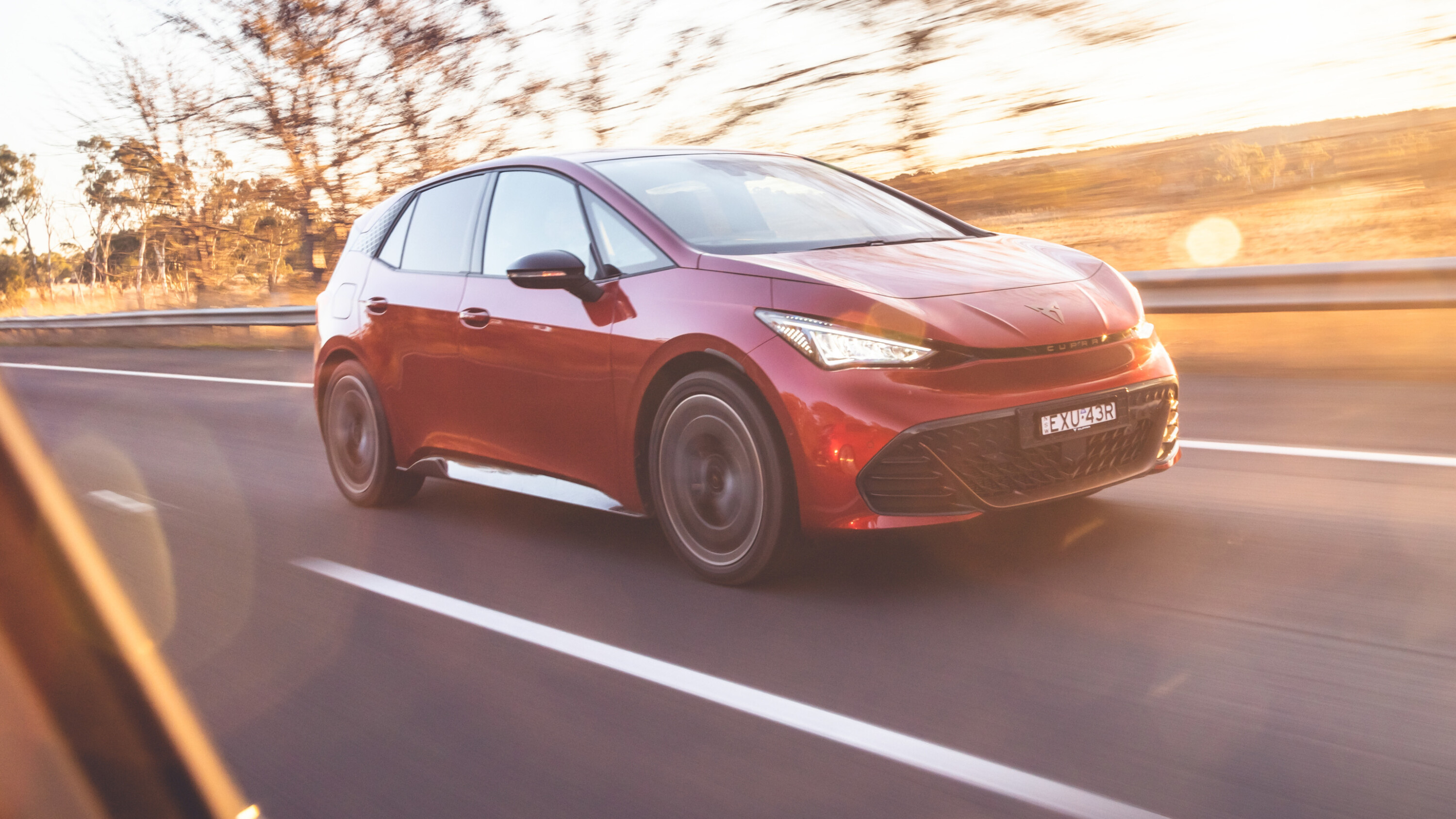
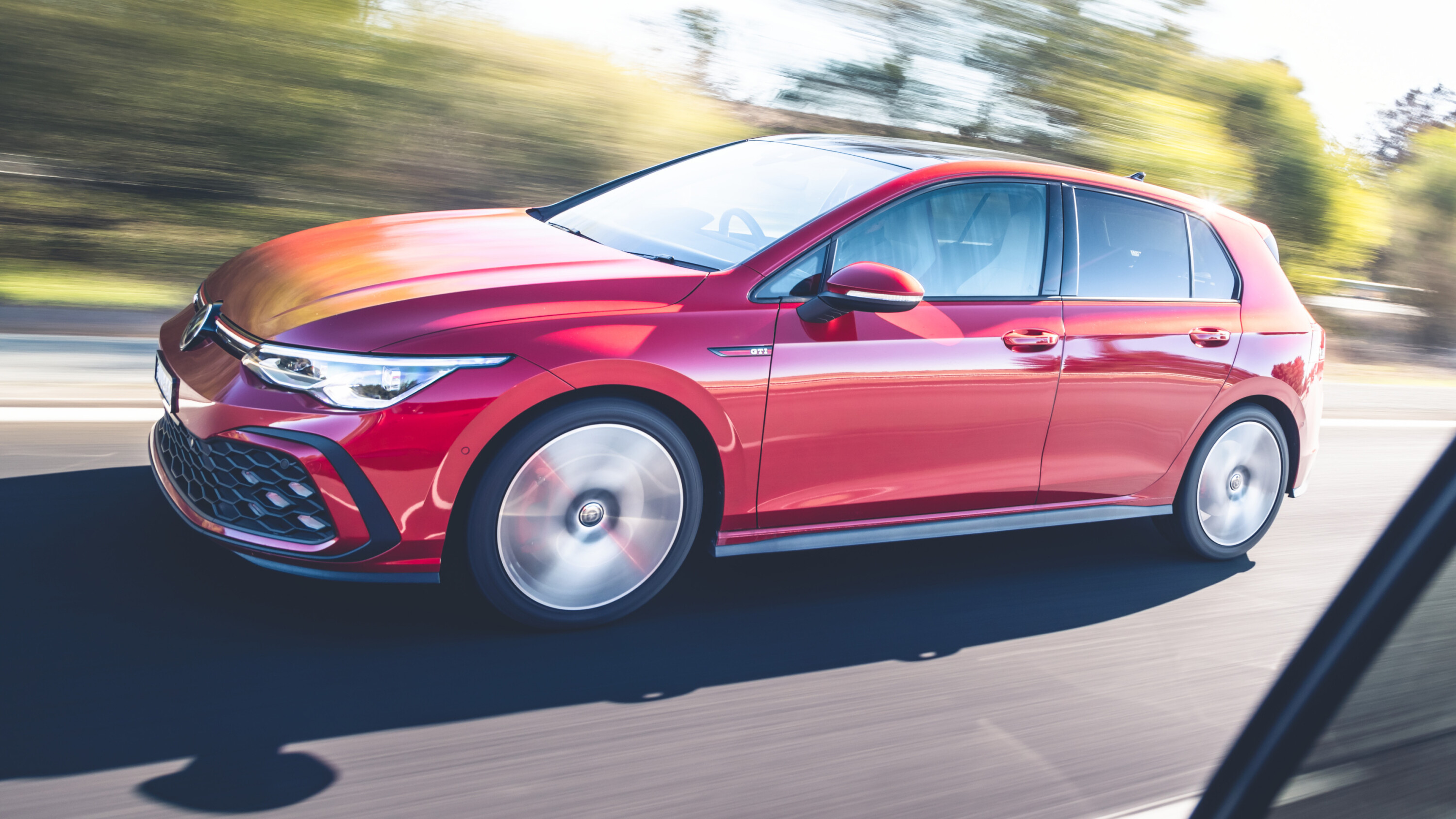
On paper, the comparison between the two is clearer than a smog-free skyline.
As tested, they’re priced within a few grand of each other – $62,590 for the Cupra Born with optional Performance package ($2600); $59,790 for the Golf GTI with optional Luxury package ($4000) and metallic paint ($300) – and in terms of overall size, they’re also surprisingly close.
The Born feels like more of a mini-MPV given its dash-to-axle ratio, its lengthy wheelbase, elevated height (it’s 77mm taller than the Golf), higher hip point, very deep windscreen and additional windows between its A-pillars and front doors, whereas the Mk8 Golf is the definition of a traditional small hatchback in both look and feel.
Yet the difference in their overall length is just 37mm (favouring the larger Cupra) and their boot volumes are near-identical. So in practicality terms (for the most part), they’re on par.
Interiors: Golf GTI
Excellent front buckets mounted lower than Cupra, and dashboard quality is superior. Likewise audio quality, though fiddly switchgear interfaces overly complex, storage areas more difficult to access.
Like Cupra, temperature slide controls lack night lighting. Slightly more rear toe room than Born but tighter for leg room, similar for overall comfort and under-thigh support.
Shares two rear USB-C ports with Cupra but gains rear air vents with temp control, better door storage (though lower-grade finish compared to front doors, and rear-seat leather deletes centre perforation).

Interiors: Born
Doesn’t really have Golf’s feeling of expense – feels cheaper, more junior inside. Padded Alcantara on doors and centre armrest, but door pressings are rock hard plastic, take large water bottles.
Superb steering wheel has Drive Mode button on the left, ‘Cupra’ sport button on the right, but capacitive switches too close to your thumbs, ‘twist’ gear selector on binnacle hidden by wheel spoke. Rear buckets almost as comfortable as front pair.
Larger multimedia screen easier to use than Golf’s. Likewise the angled wireless charging pad.
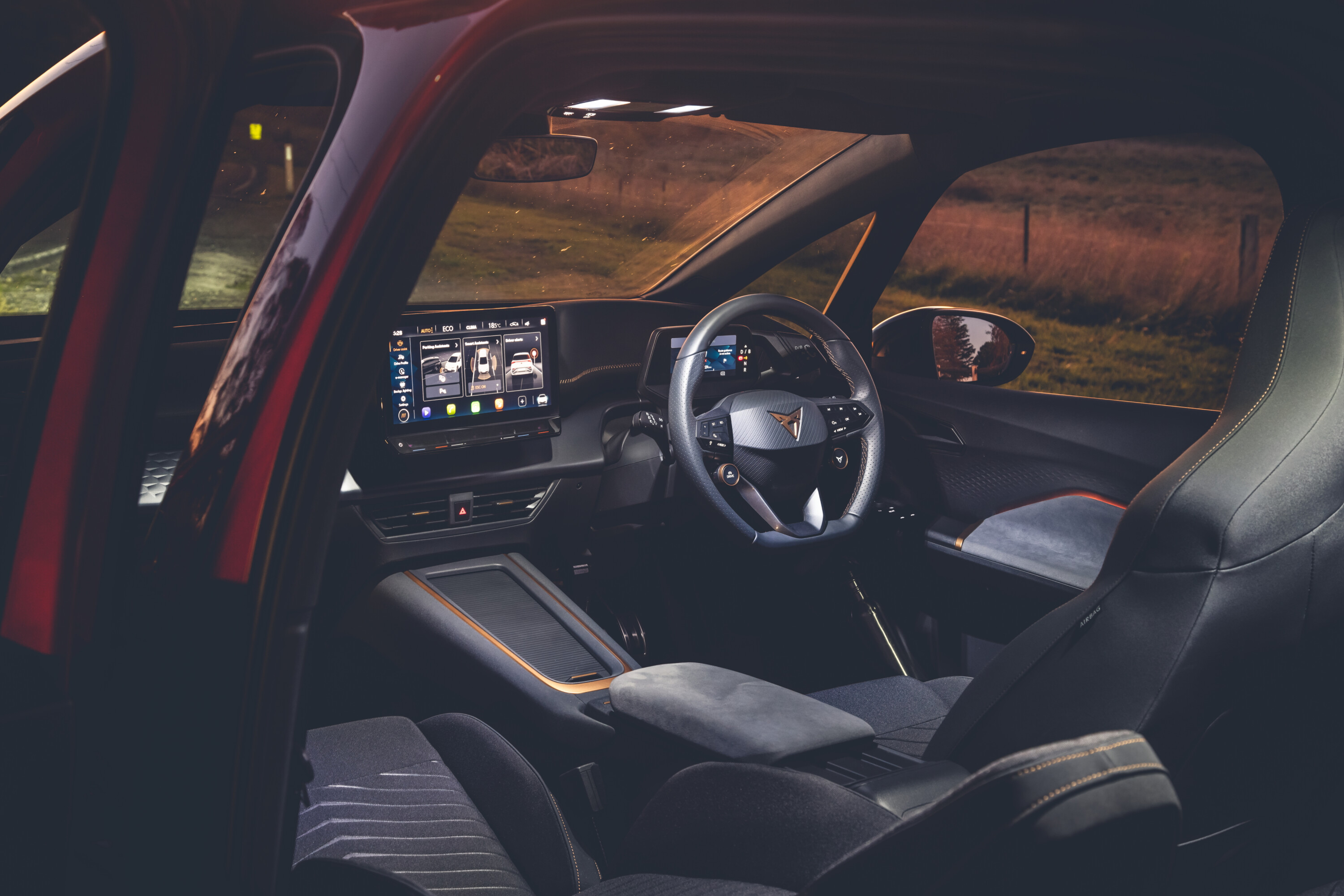
Of course, it’s the driving experience we’re ultimately here to scrutinise.
So does the Born truly achieve what the Golf GTI does? And is an electric hot hatch a viable alternative to a turbo-petrol one in 2023?
Firstly, performance. Believe the manufacturer claims and the difference in their acceleration isn’t huge – 0-100km/h in 6.4sec for the Golf versus 7.0sec for the Born – thanks to the electric Cupra’s instant torque off the line and its rear-wheel-drive traction. Indeed, Cupra claims 0-50km/h in 2.8sec, which is proper hot-hatch urgent, because the Born’s performance flavour really is all about the launch.
Its drivetrain is smoothly unobtrusive – all the things you want in an EV – and overall acceleration is strong, but the Born is far from neck-snapping and offers nothing to feel inspired by.
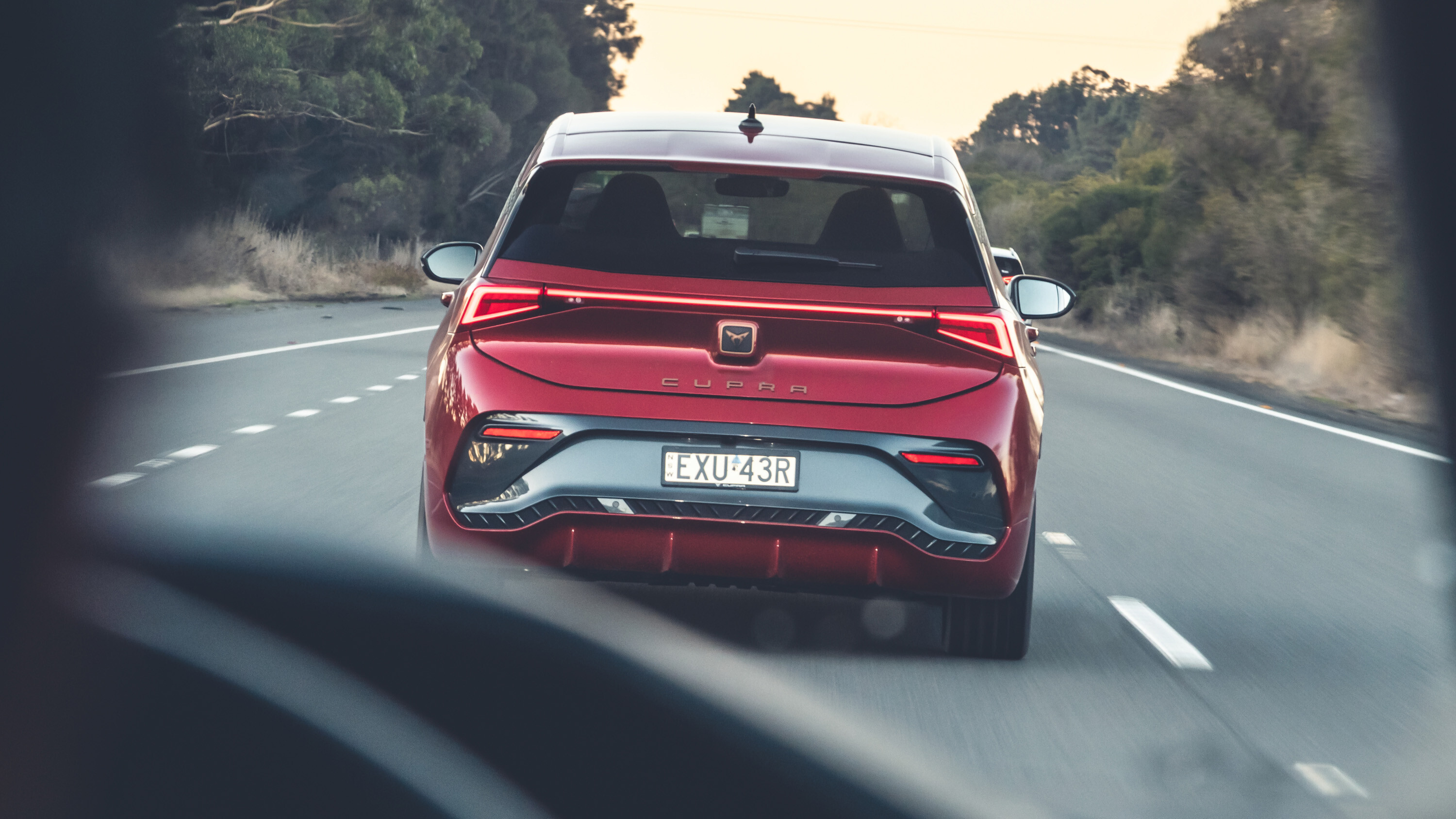
Purists will argue that buying a proper performance hatch while you still can is the only answer
Once its digital speedo reaches three digits, its performance perception begins to fade, and being electric, it lacks the upshift blurting of the Golf, or any of the petrol car’s spirit. In comparison with the Volkswagen’s unrelenting accelerative urge, the Cupra serves up more of a brisk gathering of momentum.
With the traction-enhancing smarts of its ‘extended’ electronic front differential lock, the front-drive Golf GTI hauls itself from a standing start and never lets up. In Sport mode, it hammers towards the horizon – lunging forward with every upshift, rasping from its engine and exhaust, while ultimately smashing the Born for hard-driven pace.
The greater your commitment, the greater its reward … which is the opposite of its electric rival. Indeed, today’s 180kW Golf GTI rivals the previous Golf R for pace, while delivering a better soundtrack.
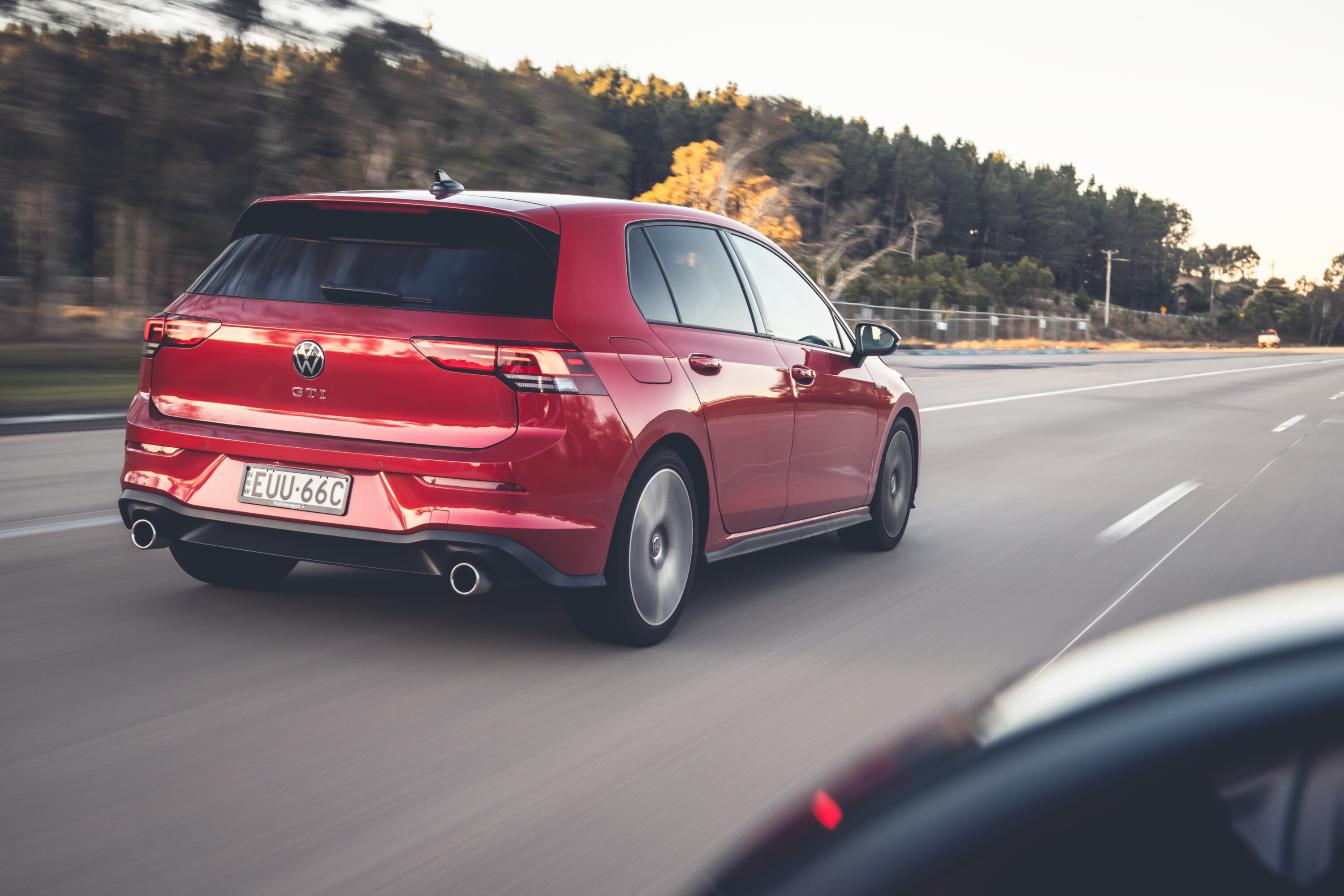
You don’t need to be ? Albert Einstein to understand the Golf has physics in its favour.
It weighs 550kg less than the 170kW/310Nm Cupra, and while it doesn’t offer instant torque, it doesn’t take long to appreciate the richness of its 370Nm from 1600-4300rpm. Yet the much heftier Cupra uses its weight to great effect when it comes to refinement and ride.
On the freeway, even when fitted with 20-inch wheels (wearing 235/40ZR20 Michelins) and adaptive dampers – both part of the optional Performance package – the Cupra in Comfort mode is quieter and much more plush than the Golf, to the point where it feels like a higher-end car. The difference is quite dramatic.
Compared to the Cupra’s soothing absorbency, even Comfort mode can’t save the adaptively damped Golf from feeling constantly firm – lower and stiffer than the Cupra, but also broader and more planted. And much louder.
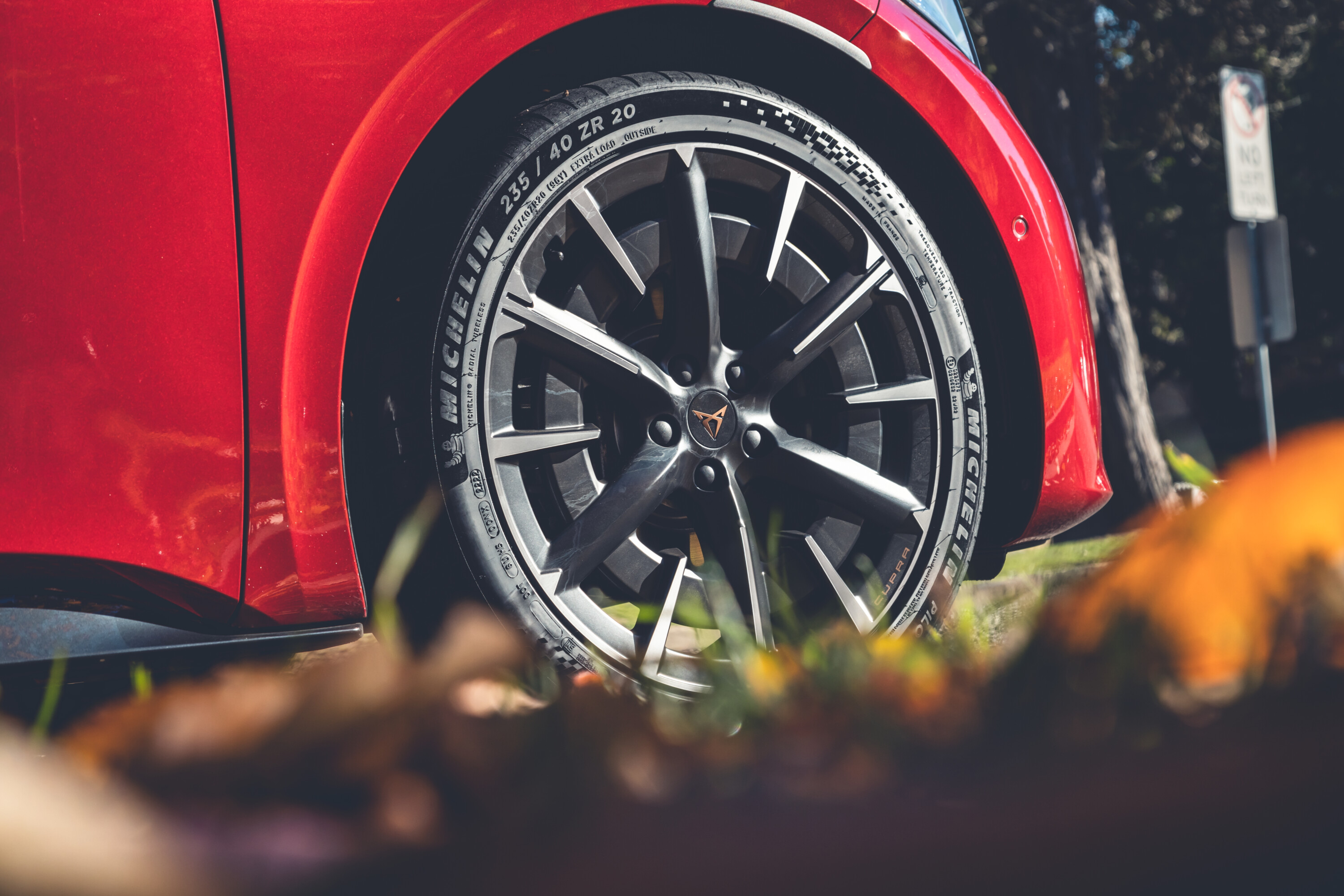
Even Comfort mode can’t save the adaptively damped Golf from feeling constantly firm
Its 225/40R18 Goodyear Eagle F1s produce loads of tyre noise – ramming home that this is an uncompromising hot hatch with the grunt to match – whereas the Cupra defines the quietness and unobtrusiveness of an EV, which isn’t really a hot-hatch thing… yet it does handle – especially in its favoured environment.
With all that battery weight mounted low, rear-wheel drive and its electric motor mounted transversely across its rear end, the Born offers close to 50:50 weight distribution, which bodes well in tight corners where you can feel the dynamic flavour of its rear-drive balance and thrust.
The harder you push, generally the better it gets – never really feeling like it’s on 20-inch wheels or that it weighs almost two tonnes. But your selected drive mode is crucial to getting the best from it.
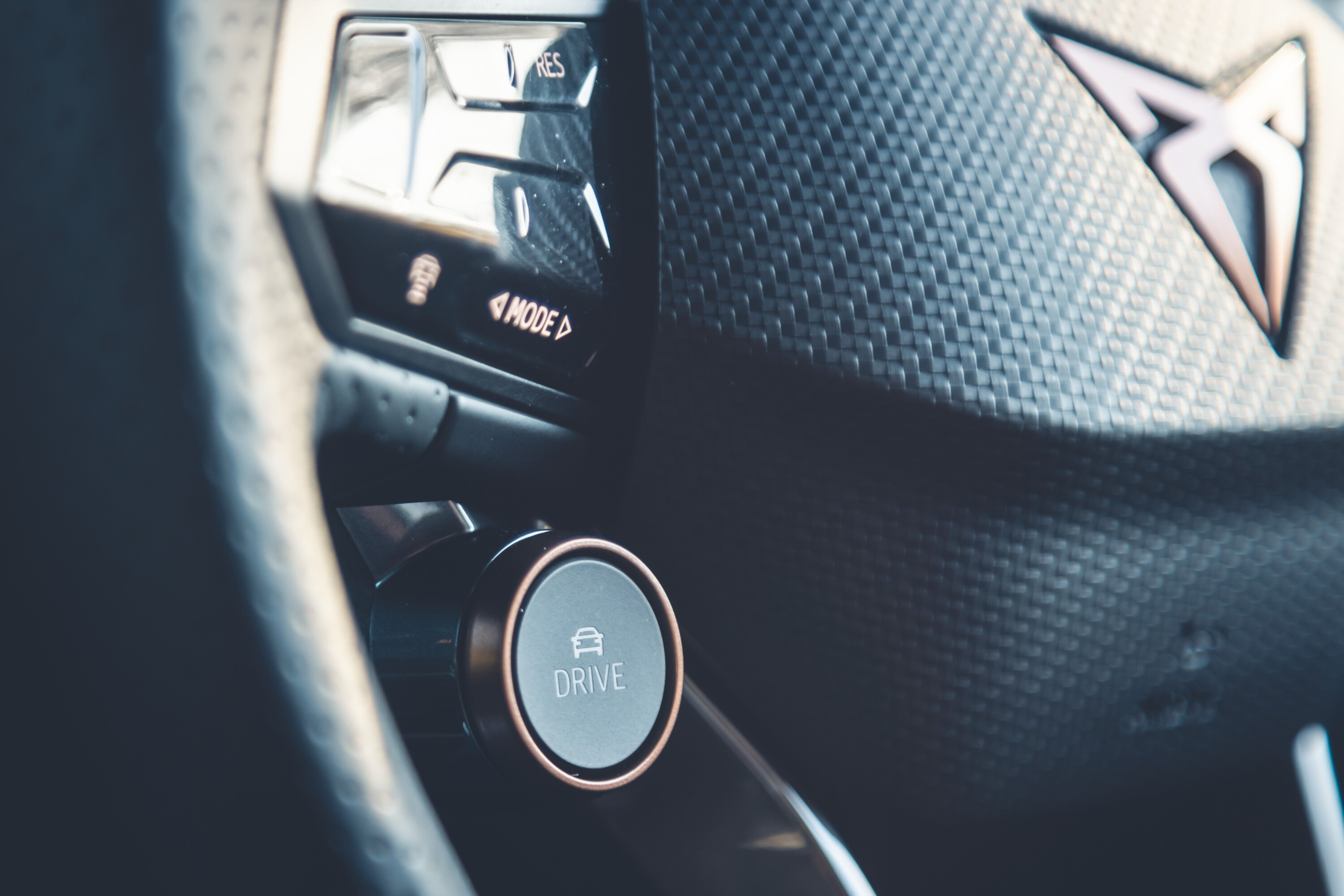
On our back-to-back test loop, its dynamic sweet spot was Individual mode, with its damping resistance positioned mid-way between the Comfort and Performance settings.
In Comfort alone, the Born might be superb on the freeway but it produces too much body movement on challenging roads, like it’s shifting around on its bushings, whereas Performance mode is completely driveable but pretty firm. The most extreme ‘Cupra’ setting is simply too stiff for most Australian country roads, even taking into account the Born’s hot-hatch focus.
Yet the Cupra’s steering needs to be set to Performance to complement its handling balance – again best achieved via Individual mode. In Comfort, the Born’s eager steering (with 2.6 turns lock-to-lock) is simply too light, doesn’t load up properly and never feels entirely natural.
The most extreme ‘Cupra’ setting is simply too stiff for most Australian country roads, even taking into account the Born’s hot-hatch focus.
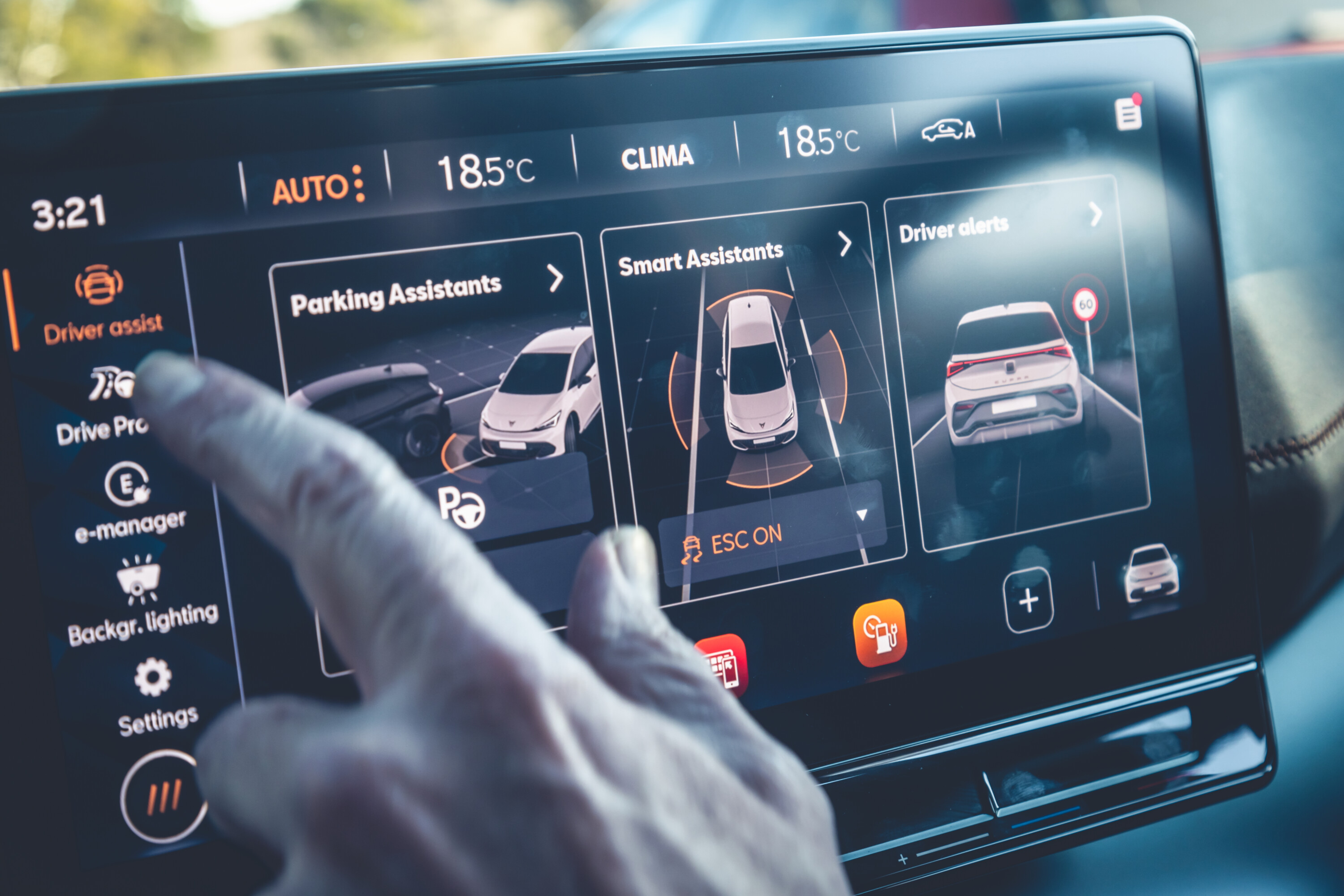
In comparison, the Golf GTI feels much more dynamically focused, though with seemingly less bandwidth. Even in Comfort mode, it’s a firmly suspended car with firmly weighted steering and a degree of dynamic aggression that places it more towards a Golf R in personality than what we’d come to expect from previous GTI generations.
There’s no doubt that the last all-petrol Golf GTI is going out on a high note, though whether its chassis has the all-round subtlety and polish of its finest forebears is another thing.
In trying to be more unapologetically track-focused, it feels like it has lost a dimension in terms of feeling great at all speeds, though as a balls-out hot hatch, it has the steering meat, the handling smarts and the ballistic pace to enhance its thrill factor. But you need to be going so much faster than previous generations to even approach its dynamic limit.
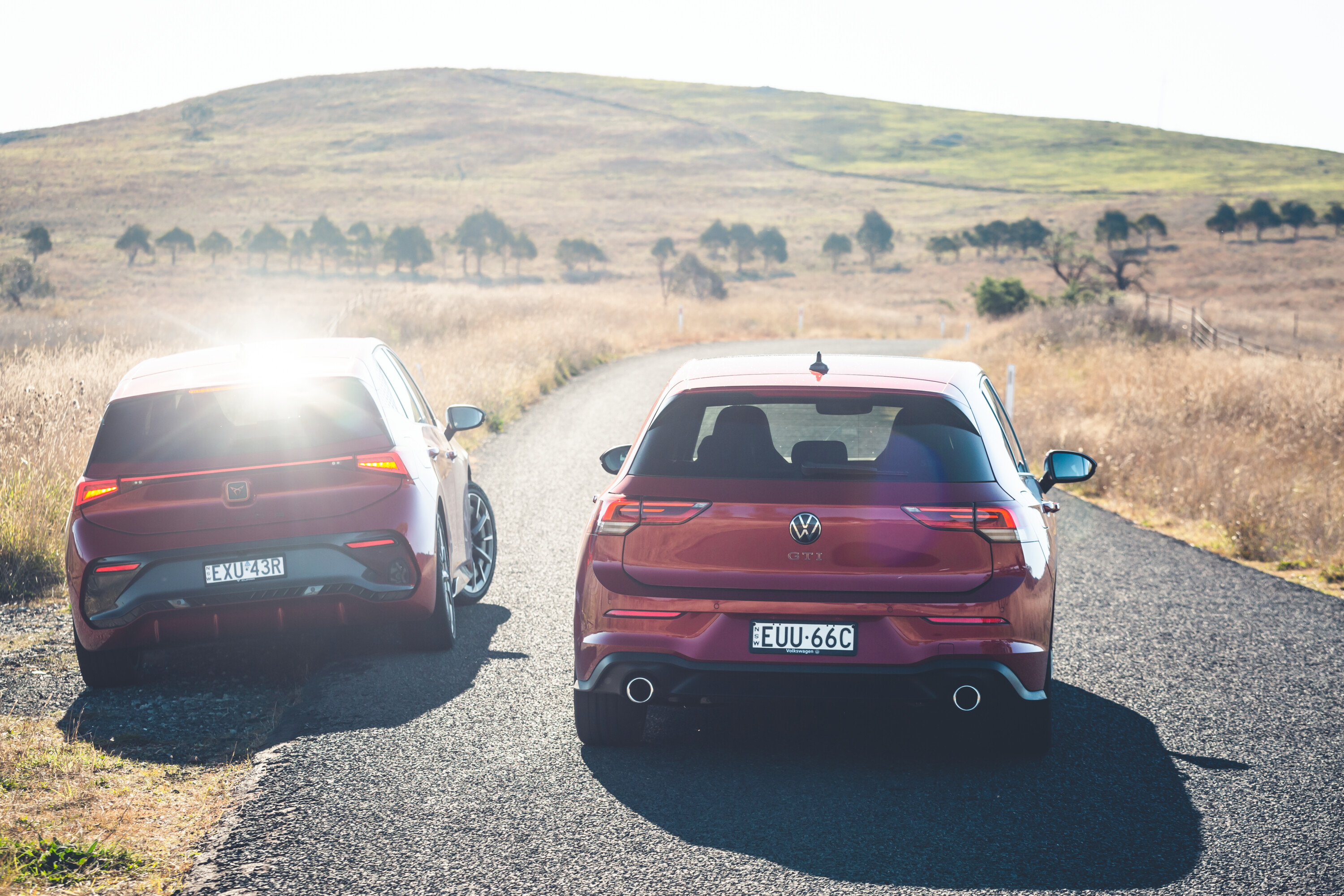
Driving hard on a tight road shows just how focused and uncompromising today’s GTI is – from its drivetrain performance to its brakes, its steering feel and even its front-wheel traction.
But on more open, flowing roads, the Cupra can show the Volkswagen a thing or two about dynamic character.
While the Born’s steering isn’t as communicative as the Golf’s, with no real feel at straight ahead or even when you’re turning in, it’s undeniably quick to respond. And once you’re turning through that numbness, its agility and change-of-direction are really impressive.
Its rear-mounted battery and rear-wheel drive can be used to great effect, and when you combine that with a dynamic nuance that allows you to adjust the Cupra’s balance with your right foot, you can see how, on the right road, the Born is worthy of being labelled an electric hot hatch – even though it doesn’t quite have the engagement of the Golf.

It’s a different flavour to what we’re used to and takes time to both discover and appreciate.
The interiors of each car also reinforce that there’s a philosophical difference here. The dash depth and the windscreen cowl of the Cupra are way in front of where the Golf’s are positioned, and you feel quite elevated even with its (full manual) seats cranked all the way down, making it feel like a bit of a mini MPV, rather than a hot hatch.
It’s also less premium in its finishes, with lower-grade plastics that make it feel like a Polo relative rather than anything from the Golf class. Cue single-piece, hard-plastic door pressings, a relatively junior-looking 5.3-inch driver’s display and a lack of much in the way of surprise-and-delight touches.
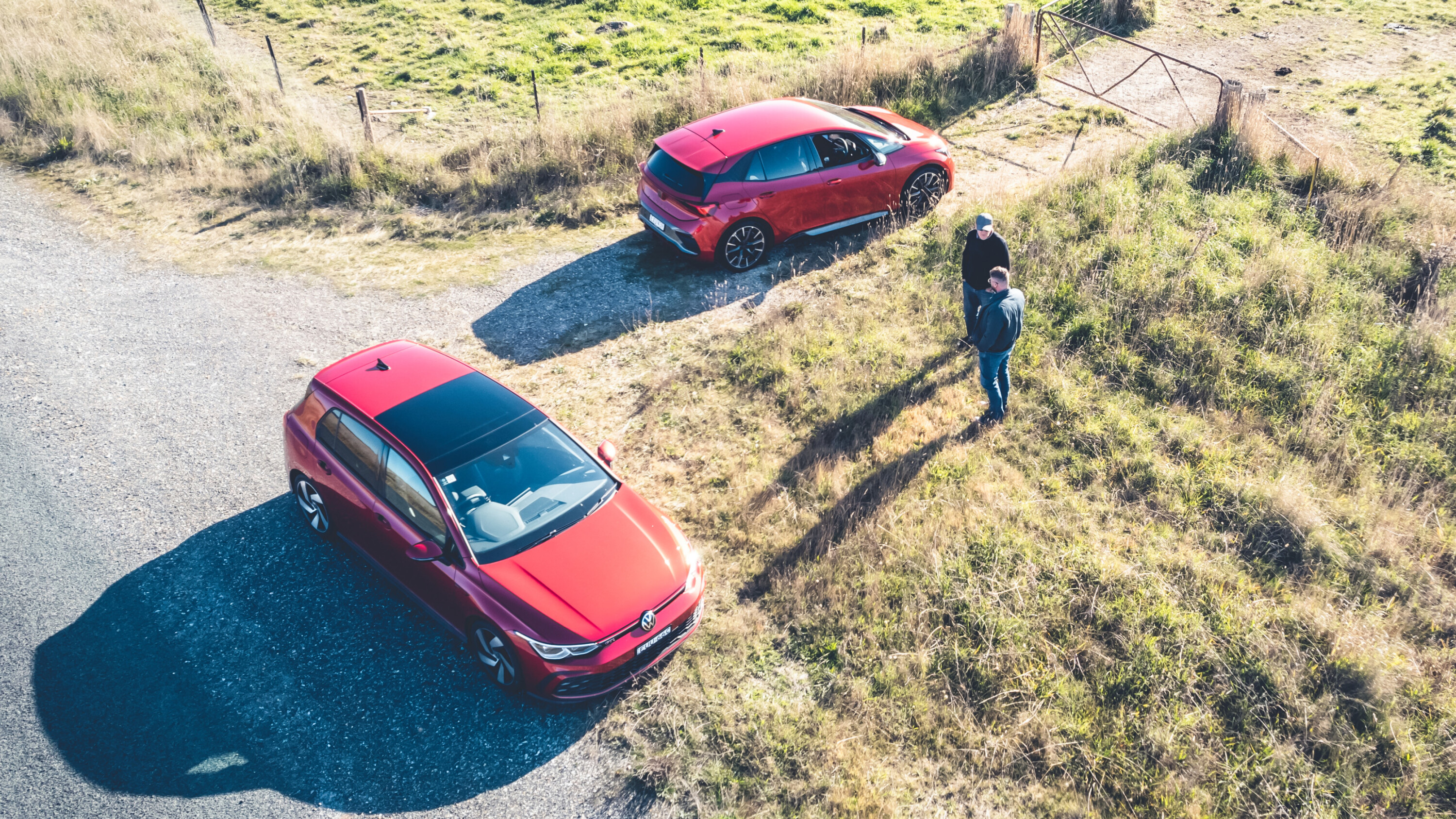
The Born is worthy of being labelled an electric hot hatch – even though it doesn’t quite have the engagement of the Golf.
A Cupra Leon has a much nicer cabin ambience than the Born does, though the simplicity of all its controls is admirable, in an era where everything seems to have become more difficult to get your head around – particularly its larger 12-inch multimedia screen.
But the Born’s standard five-speaker stereo is disappointing, with relatively thin bass production, though a nine-speaker, 395-watt Beats audio system is optional (part of a $2900 Interior package).
In contrast, the Golf feels much plusher, with higher-quality materials and screen displays, a stronger stereo (a six-speaker set-up, with a 480-watt Harman Kardon system optional), rear-seat air vents, more practical rear door designs and a proper three-person rear bench seat (the Born with Performance package gets two rear ‘buckets’ instead).
Seating number aside, they’re also pretty much on par for room, though the Golf’s fiddly switchgear set-up (via the main touchscreen and capacitive switches) is far from ideal.
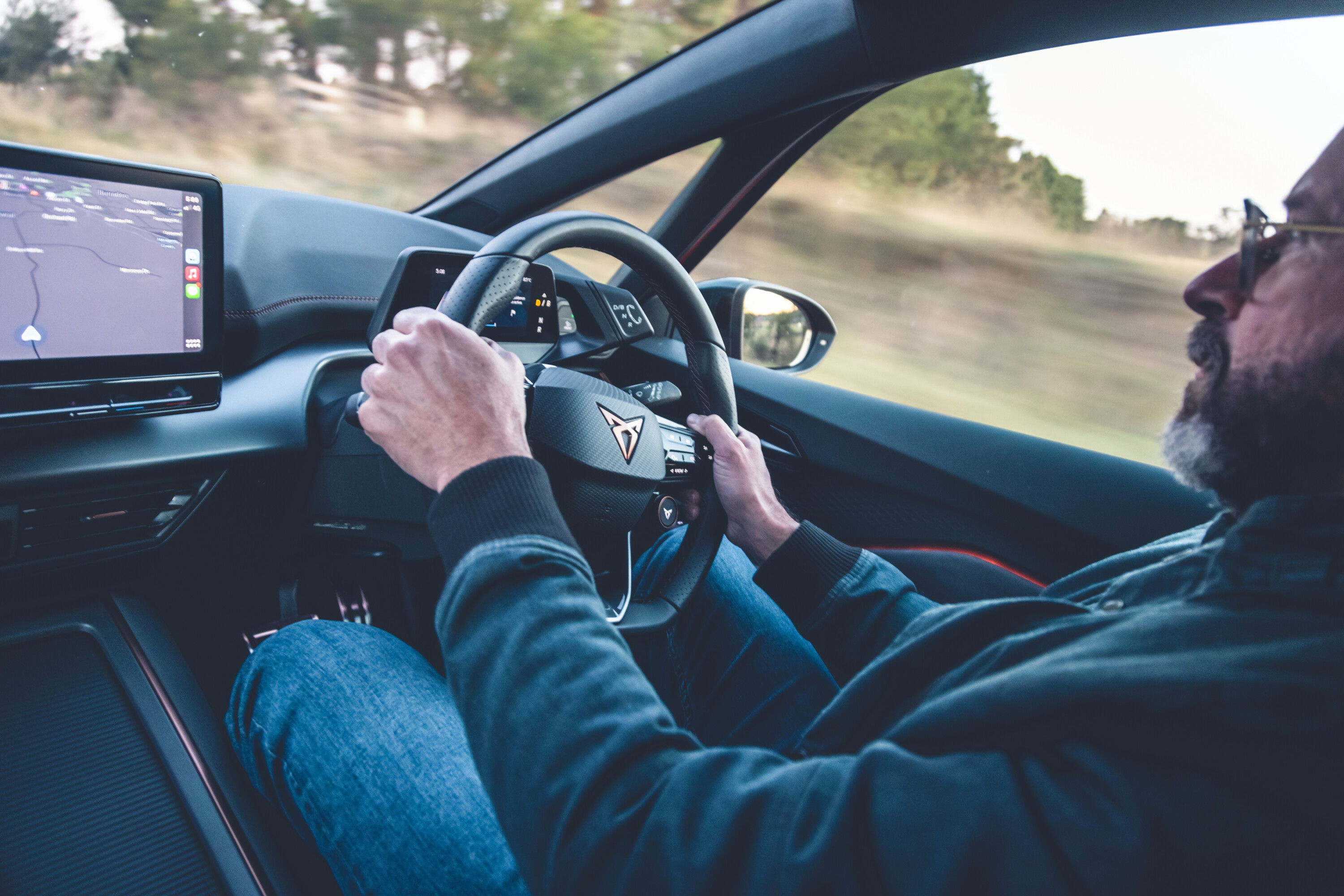
What clearly works in the Golf’s favour, however, is the elephant in the room in this whole petrol versus electric stoush – overall range.
Even with a modest 50-litre fuel tank, our test car’s 7.9L/100km average translated to 633km per tank, which is already way beyond the Born’s official WLTP range of 470km (with Performance pack fitted). Using the GTI’s official combined figure of 7.0L/100km as a guide, its range is 714km.
We noted down three readings for the Born – one for the first full battery charge (22.9kWh/100km average) which included 120km/h of steady-throttle freeway driving and our dynamic back-to-backs, meaning 336km of total range (based on 77kWh of useable battery capacity).
The second leg consisted of a casual drive back to Sydney (17.0kWh/100km, or 453km of range) while the total energy consumption over 709km of driving worked out at 21.0kWh/100km (or 367km of range). As for charging time, Cupra says the Born takes 36 minutes to go from five to 80 percent battery capacity using a fast charger.
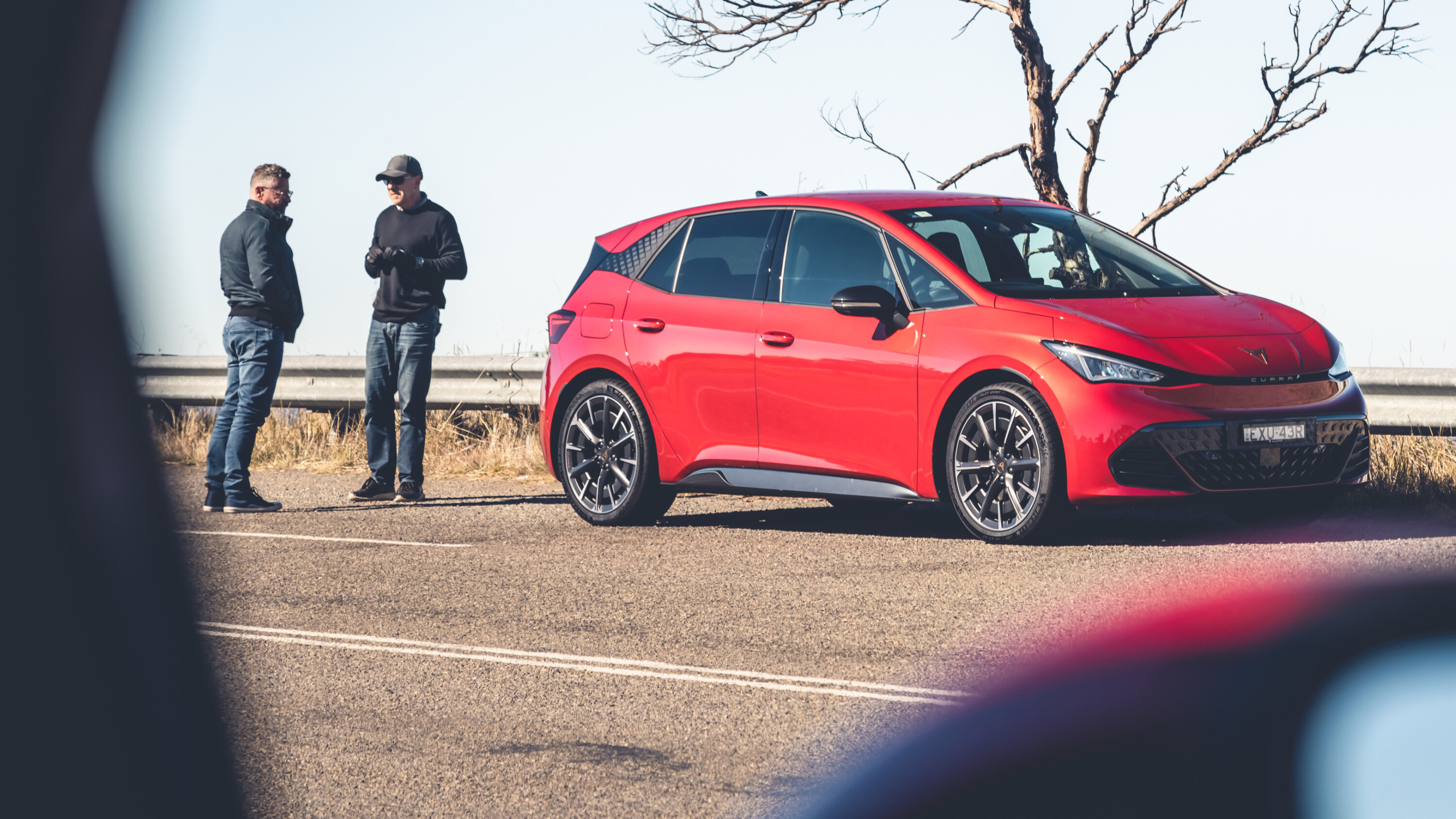
And so?
What we’re left with here is two different classes of car competing at a similar price point for essentially people who are hot hatch buyers, but in the Cupra’s case, may not necessarily be.
The Mk8 Volkswagen Golf GTI is absolutely a hot hatch for people who love hot hatches – those who will relish its ragged edges and the character that it has, particularly its brilliant drivetrain. In its latest generation, it has become a more hardcore, more track-honed hot hatch – more of a Golf R-lite, if you like. But whether it has the nuance in its dynamics that it once had is another thing.
Today’s Golf GTI has morphed beyond the all-things-to-all-people all-rounder that it once was, to the benefit of its purist appeal but to the modest detriment of its day-to-day liveability. It’s never been faster or more focused, but it’s also never been firmer. Or more expensive.
However, if this is to be your last-ever petrol hot hatch, you’re unlikely to be disappointed … aside from its flawed dashboard control interfaces.
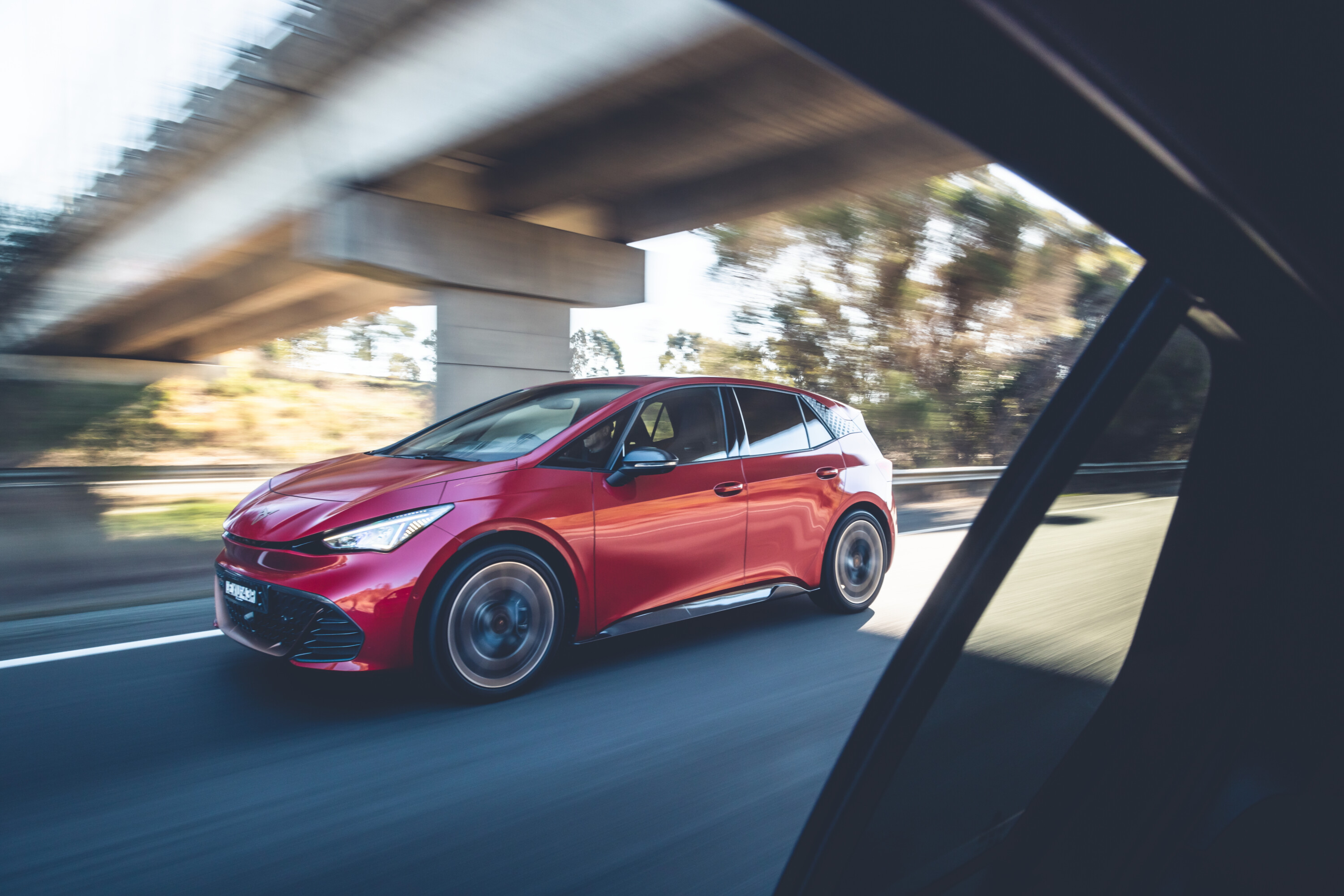
The Born, on the other hand, is an intriguing proposition. In styling detail it looks like a hot hatch, but it often doesn’t really feel like one.
Yet it has layers that gradually reveal themselves. It has more nuance in its dynamics and its drivetrain is silky smooth, but it doesn’t have the level of spirit we probably expected, or the overall performance.
Ultimately, the Golf GTI and Cupra Born aren’t chasing the same buyer. The person who finds the Cupra particularly appealing is perhaps a little less performance-oriented, and perhaps a little bit older than the person who wants to make the Mk8 Golf GTI their last new petrol-engined hot hatch.
If only the Cupra were a bit quicker and a bit more communicative, with more sophisticated cabin finishes. And if only the Mk8 GTI offered a little more comfort and refinement than it does. But the fact is that a true electric hot hatch – one with the performance and dynamic edge that the finest of this vehicle type are famed for – is still a dream of the future.
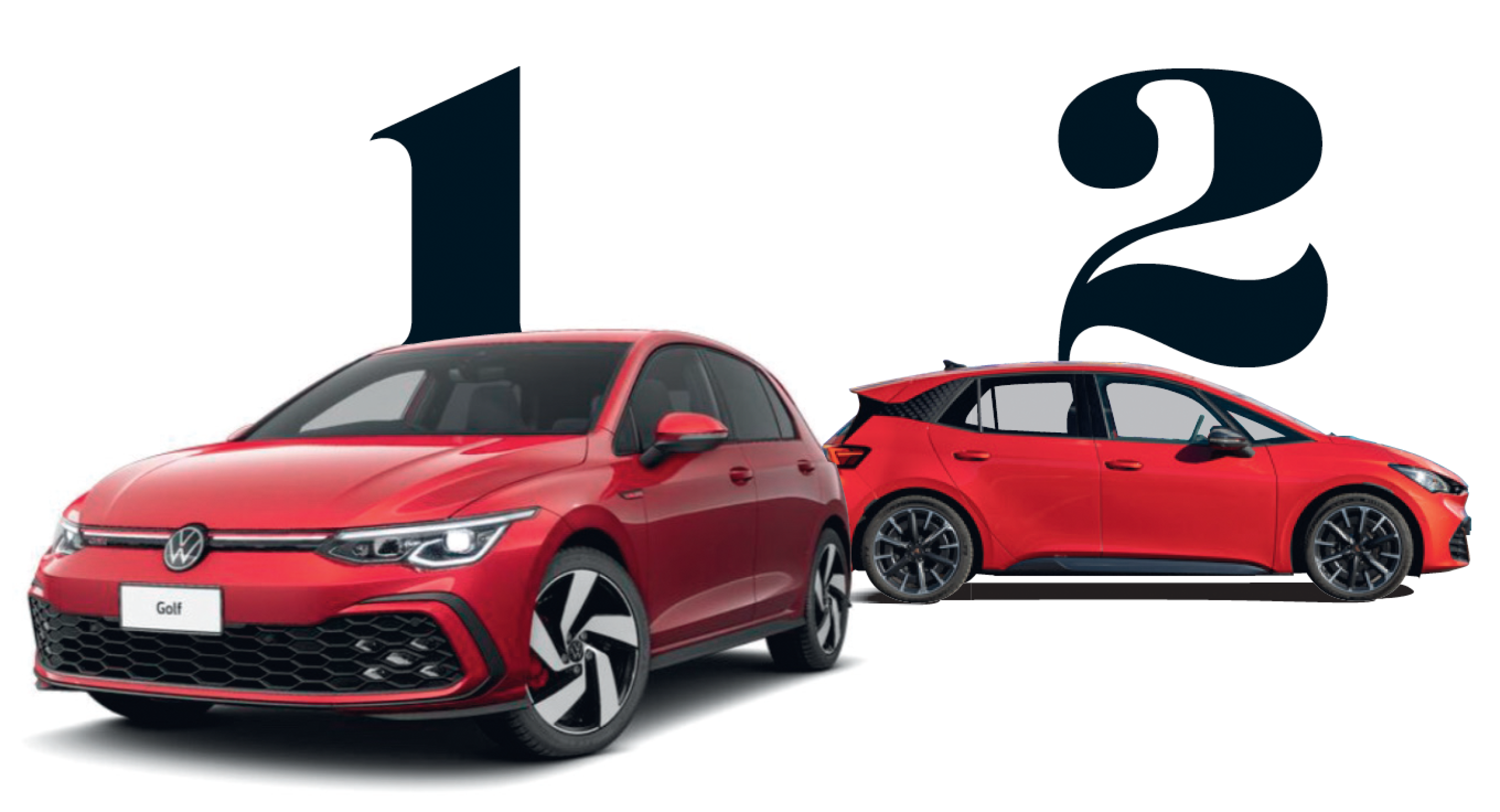
A true electric hot hatch – one with the performance and dynamic edge that the finest of this vehicle type are famed for – is still a dream of the future.
| VOLKSWAGEN GOLF GTI | CUPRA BORN | |
|---|---|---|
| $59,790 /as tested | $62,590 /as tested | |
| DRIVETRAIN | ||
| Engine | 4cyl, dohc, 16v, turbocharger | Lithium-ion battery, electric motor |
| Layout | front-engine (east-west), front-wheel drive | Floor-mounted battery, rear-mounted electric motor, rear-wheel drive |
| Capacy | 1984cc | 82kWh battery |
| Power | 180kW @ 5000-6200rpm | 170kW |
| Torque | 370Nm @ 1600-4300rpm | 310Nm |
| Gearbox | 7-speed dual-clutch | 1-speed reduction |
| CHASSIS | ||
| Body | steel, 5 doors, 5 seats | steel, 5 doors, 4 seats |
| L/W/H/Wu2013B | 4287/1789/1463/2631mm | 4324/1809/1540/2766mm |
| Track (F/R) | 1535/1513mm | 1537/1513mm |
| Weight | 1409kg | 1960kg |
| Boot | 374 litres | 385 litres |
| Fuel | 95 RON / 50 litres | n/a |
| Economy | 7.9L/100km (tested) | 21.0kWh/100km (tested) |
| Suspension | Front: struts, A-arms, adaptive dampers, anti-roll bar | Front: struts, A-arms, adaptive dampers |
| Rear: multi links, coil springs, adaptive dampers, anti-roll bar | Rear: multi-links, coil springs, adaptive dampers | |
| Steering | electric rack-and-pinion | electric rack-and-pinion |
| Brakes | ventilated discs (340mm) | ventilated discs (340mm) |
| Rear brakes | solid discs (310mm) | drums (280mm) |
| Tyres | Goodyear Eagle F1 | Michelin Pilot Sport EV |
| Tyre size | 225/40R18 92Y | 235/40ZR20 96Y |
| SAFETY | ||
| ANCAP rating | 5-stars | 5-stars |
| PERFORMANCE | ||
| 0-100km/h | 6.4sec (claimed) | 7.0sec (claimed) |
| VERDICT | 8.0/10 | 7.5/10 |
We recommend
-
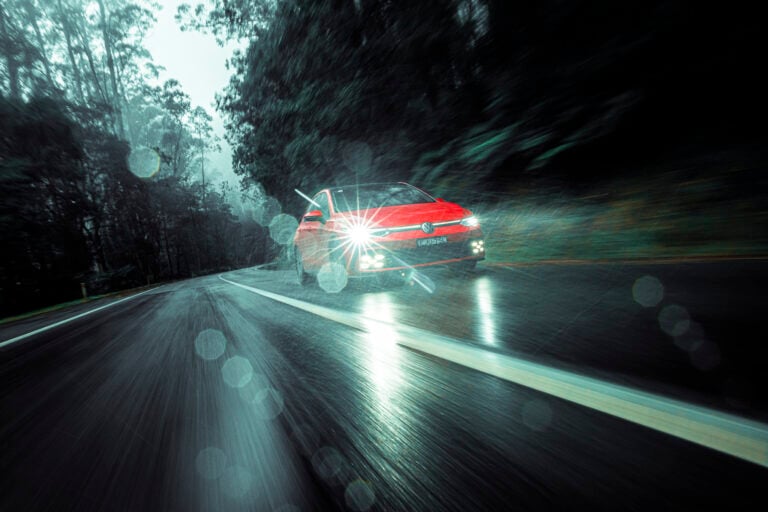 Features
Features2021 Volkswagen Golf GTI feature review
Volkswagen isn't content with resting on its laurels with the MK8 Golf GTI. But has it messed with a perennially winning formula?
-
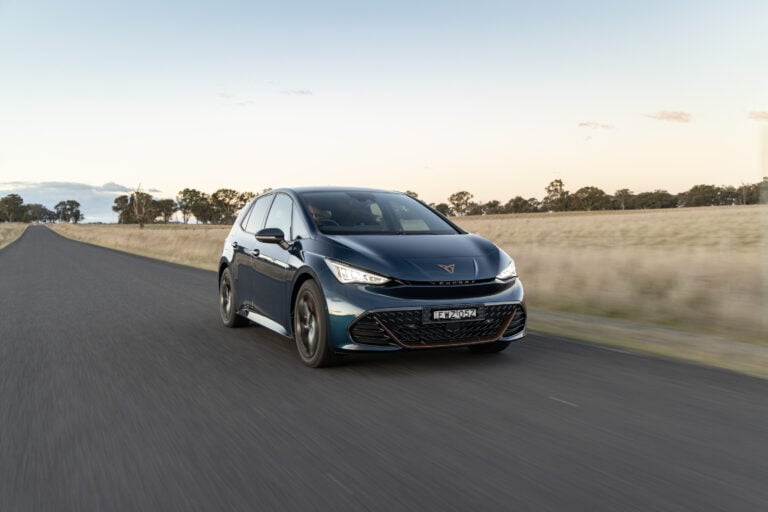 Reviews
Reviews2023 Cupra Born EV review: Australian first drive
Cupra's Born is a stylish and pragmatic weekday warrior, with enough power and stamina for plenty of weekend fun
-
 News
NewsNew car calendar 2026: All the new cars coming to Australia next year
Here’s the WhichCar by Wheels guide to all the new cars that will launch in Australia in 2026. Check back in regularly for updates...



